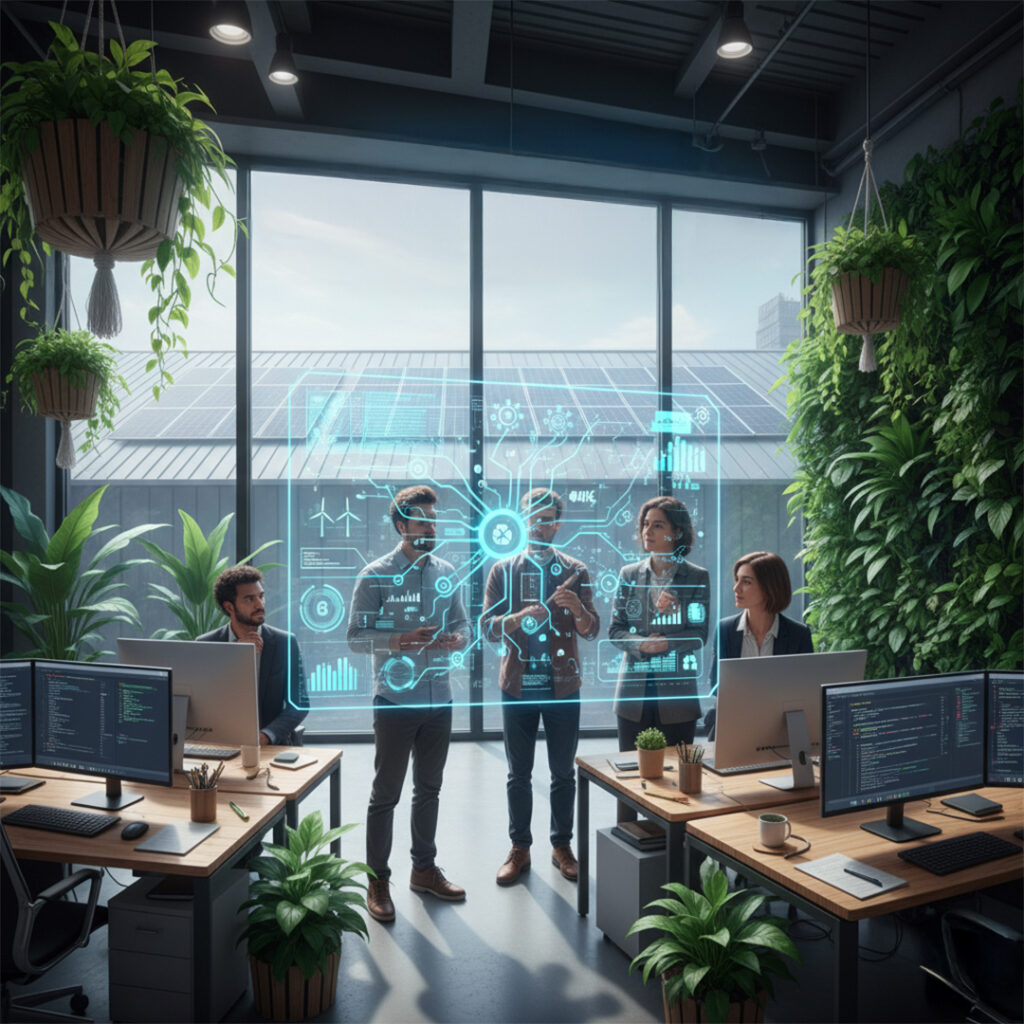How Sustainable Software is Powering Innovation from FinTech to GreenTech
In markets where disruption is the norm and environmental responsibility is expected, companies are increasingly turning to sustainable software as a strategic asset – one that not only drives business performance but also supports greener outcomes. Whether in banking, clean power, or mobility, the shift from consumer-finance tools to Greentech solutions shows how innovation and sustainability are converging. Behind this transformation is the work of a skilled software development company, guiding organizations through custom software development that embeds efficiency, impact and flexibility from day one.
As the pressure mounts for businesses to deliver both scale and sustainability, bespoke software, not off-the-shelf platforms, has emerged as a differentiator. A thoughtful software development company enables firms to build systems tailored to their purpose, aligned to eco-goals, and capable of integrating emerging technologies like AI software solutions and generative AI development. In this way, technology becomes a vehicle not just for function, but for purpose.
Let’s explore how AI software development company partnerships, deep tech stacks and AI integration services are shaping the next generation of software for sustainable industries. Whether it’s embedding carbon-tracking features, optimizing energy use, enabling circular economy platforms or enabling next-gen finance models, the combination of custom software expertise and sustainability ambition is opening new frontiers.
Why Sustainable Software Matters
It’s no longer enough for software simply to work. The new standard demands that systems operate with minimal environmental impact, support long-term sustainability goals and enable resilient business models. The concept of sustainable software reflects this shift: software built to last, to consume less, to integrate with greener infrastructures and to deliver business value while reducing ecological footprint. Researchers argue that sustainability in software must be “multisystemic and stratified” – covering environmental, social and technical dimensions.
In sectors such as Greentech solutions, the need is especially acute. Energy companies, smart-city operators and circular-economy firms all rely on custom systems to gather data, automate impact-pooled processes and deliver dashboards of progress. Partnering with a software development company that understands these paradigms – offering custom software development services tuned for green tech – is vital. Technology here isn’t an add-on; it’s the foundation of a new value proposition.
How AI Accelerates Sustainable Innovation
While sustainability has traditionally meant resource-saving hardware or process redesign, the addition of AI development or software solutions has brought a leap in capability. Consider how AI integration services enable real-time analytics, anomaly detection in energy grids or optimized production flows in manufacturing. A business working with an AI software development company can build digital twins, predictive-maintenance systems and automation that reduce waste and boost productivity.
Moreover, generative AI development brings creative leverage: algorithms can propose design variants for low-carbon materials, optimize logistics to minimize fuel use or model scenarios for circular-economy products. When these capabilities are embedded in the custom software stack, sustainability becomes not just a target but a design factor.

Key Use-Cases Across Industries
FinTech Reimagined for Sustainability
Financial services firms are moving beyond traditional lending and payments to ESG-scored portfolios, carbon-offset marketplaces and sustainable investments. Here, custom software development allows banks to embed carbon-tracking, impact-scoring and clean-finance flows in their platforms. By working with a software development company experienced in sustainability, organizations can build systems aligning financial performance with environmental outcomes.
GreenTech Platforms Built for Impact
In the energy, utilities and resource-management sectors, Greentech solutions are powered by software that monitors consumption, automates grid balancing, manages renewable-energy sources and supports circular-economy flows. Tailored software built through custom software development and layered with AI software solutions enables real-time decision-making, reduced waste and scalable green operations. One provider describes how software enables “smart, sustainable, efficient” systems across water, agriculture and energy.
Manufacturing and Supply-Chain Innovation
Manufacturers seeking to reduce their footprint and supply-chain emissions are turning to software that tracks lifecycle impact, forecasts demand, and optimizes logistics. Partnering with an AI software development company and using AI integration services, these firms enable monitoring from raw material sourcing to product end-of-life. The result: systems that are both performant and sustainable.
The Blueprint for Building Sustainable-First Software
Embarking on this journey means more than adding a “green” tag. Businesses must adopt a blueprint where sustainability is baked into architecture, development and operations, with the help of a trusted software development company. At its core, this involves three pillars:
1. Purposeful Architecture & Efficiency
Designing software with minimal waste and maximum longevity demands attention to both structure and execution. The concept of sustainable software advocates building applications that consume fewer resources, run longer and are designed for adaptability. Partnerships in custom software development support this by tailoring solutions to business logic, avoiding unnecessary complexity and overhead.

2. Integration of Intelligence and Automation
With AI software solutions and generative AI development, companies unlock deeper insights and smarter workflows, enabling sustainability outcomes that scale. Whether through predictive analytics, energy optimization, dynamic resource allocation, or circular-economy modelling, these capabilities hinge on integrative platforms built by teams that specialize in AI integration services.
3. Lifecycle Thinking & Continuous Improvement
Green-first software demands a shift from static release cycles to continuous evolution. A software development company must embed processes for monitoring, analytics, update-ready architecture and long-term support. Sustainability is a journey, not a checkbox. By partnering with a provider skilled in both custom software development and eco-design principles, organizations lay the groundwork for meaningful transformation.
Creating the Right Partnership
Choosing the right partner is critical when the stakes include both business growth and sustainability. The ideal firm is not only a software development company familiar with green goals, but also an AI software development company capable of integrating smart capabilities. They should offer:
- Experience in delivering AI software solutions for purpose-led clients
- Track records in custom software development for sustainability sectors
- Competency in AI integration services – connecting AI with operations, data and business logic
- Capacity for generative AI development – innovating and scaling design and process workflows
Such partnerships help companies transform legacy systems into dynamic platforms where sustainability, innovation and business growth converge.
Challenges and How to Overcome Them
While the promise of sustainable software is clear, the path can be rocky. Data privacy, regulatory compliance, legacy constraints, and measuring ROI all challenge teams. In sustainability software, another layer arises: quantifying environmental impact, designing for circular workflows, and aligning with ESG frameworks.
To succeed, organizations should begin with small pilots, set measurable green and business KPIs, iterate fast, and partner with specialists in AI software development company services. Early success builds buy-in, and continuous measurement ensures both business and sustainability targets are met.
The Business Case: Why It’s Worth It
Sustainable platforms support both the planet and profit. By optimizing resource use, reducing waste, enhancing brand reputation and unlocking new service models, Greentech solutions built via custom software development create strategic advantage. Software that integrates intelligence, automation and sustainability becomes a differentiator – fueled by AI software solutions and built by software development company expertise.
As enterprise goals shift toward net-zero, circularity and resilient operations, companies that invest in sustainable software now position themselves ahead of competition. It’s not just about compliance – it’s about innovation.
Conclusion
From Greentech solutions to next-gen financial models, the intersection of technology and sustainability is reshaping industries. At that intersection lies custom software built with purpose – software that enables businesses to lead and endure. By partnering with a seasoned software development company, leveraging AI software solutions, investing in generative AI development, and embedding AI integration services, companies can not only meet today’s challenges but build platforms ready for tomorrow’s opportunity.
In short: sustainable innovation begins in software. If your strategy calls for growth, resilience and impact, make sustainable software the foundation. The future doesn’t wait – so build it.


